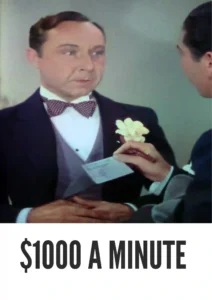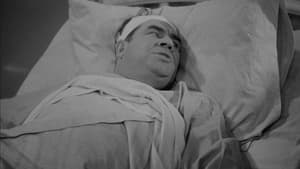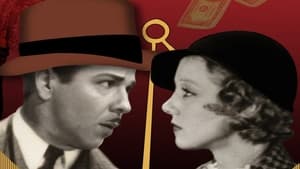Video Sources 0 Views
- $1000 a Minute 1935 Colorized

Download $1,000 a Minute (1935) Colorized HD | Roger Pryor | Screwball Comedy Gem
Synopsis
Table of Contents
ToggleFast Money and Madcap Schemes: $1,000 a Minute (1935) in Vibrant Color

Dive into the zany world of 1930s screwball comedy with $1,000 a Minute, a lighthearted and fast-paced film from 1935, now beautifully colorized for a fresh viewing experience. Starring Roger Pryor, this film delivers a delightful blend of humor, romance, and madcap schemes as a down-on-his-luck reporter suddenly finds himself in charge of a whole lot of money. Perfect for fans of classic comedies and those seeking a feel-good vintage movie, this HD download brings a forgotten gem of early cinema to life.
$1,000 a Minute Storyline: A Reporter’s Wild Ride
$1,000 a Minute tells the story of Wally Jones (Roger Pryor), a struggling reporter who gets caught up in a wild scheme when he’s unexpectedly entrusted with a large sum of money. Tasked with investing the funds wisely, Wally finds himself in a series of hilarious and chaotic situations as he tries to navigate the complexities of the financial world.As Wally juggles his newfound responsibilities, he encounters a colorful cast of characters, including a beautiful gold digger, a con artist, and a wealthy eccentric. With the help of Dorothy (Leila Hyams), Wally attempts to maintain his integrity while trying to make the most of his unexpected opportunity. The film culminates in a series of comedic misunderstandings and surprising twists, showcasing the lighthearted charm of classic screwball comedies. Ultimately, $1,000 a Minute is a delightful and entertaining film that captures the spirit of the 1930s.
Movie Cast
The film features a talented cast of actors who bring this comedic story to life:
- Roger Pryor as Wally Jones
- Leila Hyams as Dorothy
- Edward Brophy as Pete
- Sterling Holloway as Milton
- Patsy O’Byrne as Ginger
Movie Genre
$1,000 a Minute falls into the genre of screwball comedy, with elements of romance and satire that are characteristic of 1930s cinema. Its fast-paced dialogue and wacky situations make it a delightful and engaging film.
Historical Context: The Golden Age of Comedy
Released in 1935, $1,000 a Minute represents a high point in the golden age of comedy, showcasing the era’s characteristic wit, charm, and madcap energy. The film reflects the cultural and economic realities of the time, offering a lighthearted escape from the challenges of the Great Depression. While $1,000 a Minute may not be as widely known as some of the era’s biggest hits, it offers valuable insights into the comedic sensibilities of the 1930s.
Colorization Details
This colorized version of $1,000 a Minute has been meticulously restored using modern digital techniques, enhancing the visual appeal while preserving the film’s original charm and humor. The colorization process involved carefully analyzing the grayscale tones of the original black and white footage and assigning appropriate colors to each scene. While the specific software used remains proprietary, the techniques employed included advanced algorithms for color palette selection and image enhancement. This painstaking process brings new life to the characters and settings, making the story even more engaging for modern audiences. While some may debate the merits of colorizing classic films, it introduces these films to a broader audience, ensuring their legacy for future generations.
Technical Details
- Director: Richard Thorpe
- Screenplay: Samuel Ornitz, Horace McCoy, Olive Cooper
- Story: Melville Baker, Richard Connell
- Cinematography: Milton R. Krasner
- Edited by: Ralph E. Winters
- Production Company: Republic Pictures
- Distributed by: Republic Pictures
- Runtime: 70 minutes
Technical Specifications
- Download Format: MP4
- Resolution: HD (1080p)
- Compatibility: Compatible with most devices, including smartphones, tablets, computers, and smart TVs.
Reviews and Critical Reception
$1,000 a Minute (1935) is often seen as a delightful example of 1930’s screwball comedy, offering a glimpse of the era’s characteristic wit, charm, and madcap energy. While it may not be considered one of the biggest hits of the time, it remains a fascinating and entertaining example of early American cinema. As a relatively obscure but intriguing film, $1,000 a Minute provides a unique perspective on the comedic sensibilities of the 1930s.
FAQs
- Q: What is $1,000 a Minute about?
- A: $1,000 a Minute is a screwball comedy about a reporter who gets caught up in a wild scheme when he’s unexpectedly entrusted with a large sum of money.
- Q: Is $1,000 a Minute (1935) a well-known film?
- A: $1,000 a Minute is one of the era’s lesser-known works, offering a glimpse into early comedic style and themes.
- Q: Is this version of $1,000 a Minute colorized?
- A: Yes, this version has been professionally colorized to enhance the viewing experience.
- Q: What makes $1,000 a Minute interesting for classic film fans?
- A: $1,000 a Minute offers valuable insights into the comedic sensibilities of the 1930s.
- Q: What is the download format?
- A: The download format is MP4, which is compatible with most devices.
- Q: What resolution is the download?
- A: The resolution is HD (1080p), providing a high-quality viewing experience.
Download Now in HD!
Watch $1,000 a Minute Today!












